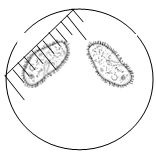 Aim
Aim
Measuring organisms seen under the microscope
to learn about growth.
Observing, measuring and learning the units of used in the measuring microorganisms.
Class level : 9th-12th grade;13 – 18 year olds.
Introduction:
You have learnt how to use a microscope and how to prepare a culture to grow organisms. From your microscopic observation you have already seen that the Paramecium grew in size in the culture. This activity will help learn to measure organism seen under microscope. We shall also examine the concept of growth in general and growth of paramecium in particular
Growth : How can one say that something is growing? What parameters do we use to measure growth? Increase in number? Increase in size, shape or mass? What about decrease in number? Is that growth?
Growth can be positive and negative.
So the parameter we shall adopt would be to see if the paramecium is growing in length and through approximation we shall try and find if there is an increase in numbers.
SI Units for length
1000 Meter = 1 Kilometer
1 Meter (m) = 10 dm
1 Meter = 100 cms
1 Meter = 1000 millimeters (mm)
1Millimeter = 1000 micrometer (µm)
1 Micron (µm) = 10 -6 m or 10 -3 m
1Angstrom (Å) = 10-10m or 0.1nm
1 Nanometer(nm) = 10 -9 m
The box above gives you some. commonly used standard units.
Growth is defined as an irreversible change in
the dry mass of living being.
Can you justify this statement with reasons ?
Support your argument with adequate examples?
Before we test hypotheses of any kind, we will first learn to measure the length of an organism viewed under the microscope. The procedure given here will not give you a data that is scientifically accurate. It will merely enable you to design a tool that can be used to check the growth of paramecium. That is the primary aim of this activity.
Materials needed : Millimeter ruler; Carmine solution; dropper; glass slides; cover slips; paramecium culture;
When your microscope is ready for use, look through the ocular lens( the eye piece). Do you observe a well lit circular space? That is generally referred to as ‘field of view’.
Why does the field of view appear circular?![]()
Can the brightness of the field of view be reduced?
Is reduced light an advantage for seeing a sharper image?

This is a millimeter ruler that you can print and use if needed. Some microscopes have a scale attached to them along with the stage clips, to help you with measurement.
Step 1. Find the diameter of this field of view using the mm ruler or the scale that is found attached to the stage of the microscope. Using the stage scale would be a better option. If you are using the paper ruler, then make sure that it is correctly copied on a transparent sheet of paper.
Why a transparent sheet and not a regular one?

This is how the mm scale will appear in the field of view. The distance between any two lines is 0.1mm
Step 2. You already have a culture of paramecium with you. They are live paramecium and hence you would have noticed that they are actively moving about in water. Therefore we need to first slow them down so that we can measure their length or width. Take a drop of water ( make sure) with some paramecium in it. You can see fully grown paramecia as small white dots in the water drop ( if you so desire ,double check by viewing them under microscope).You can also add a tiny drop of carmine solution to stain it. Make sure that both the water drop and stain drop is small!
Step 3 . Ask the lab assistant to open a bottle of Acetone; Deftly upturn your slide with a drop of water and run it over the bottle.
The water drop does not spill into the bottle,why?
The vapours of acetone slows down the activity of paramecium and makes I very sluggish. It would now be easy for you to measure its length/width. Now place a cover slip over the drop of water and the slide is ready for the microscope.
Step 4. Place the paper scale over the stage such that the readings on the scale are visible. Use a tape to secure them at the two ends of the stage so that they do not move.
Step 5 : Now place the paramecium slide over this and bring it to a focus.Look through the eye piece and move the slide slowly so that at least one of the paramecium comes over the readings on the scale.

In this fig. the paramecium is occupying 8 subdivisions of the scale. So what is the reading?
Count the number of millimeters or the tenths of millimeters from one side of the field to the opposite side. For the above figure the reading would be 0.7mm. Repeat your count with another paramecium. Try to get the readings of at least 3 paramecia and calculate the average length.

The paramecium in this fig occupies only 3 subdivisions=0.2mm
For eg If The paramecium was measured to occupy say a space in which you see 9 subdivisions of your millimeter scale, then its length can be read off as 0.8mm.If the second one was 0.7mm and the third was 0.5mm, then the average length of the paramecium can be calculated and would be 0.62mm
Now since we do know that 1mm = 1000 micrometer or µ we can calculate the length of
Paramecium in microns by multiplying 0.62 by 1000 and arrive at the answer to be 620 µ.
Please remember that such a calculation is not scientifically acceptable as accurate and is meant only as a parameter to investigate growth.
Accurate measurements
Those who would like to learn more about accurately calculating the size would need a scale (called a reticule) that is built into one eyepiece.It is easily available but seldom used in schools.You would also need a stage micrometer. For more on this please see
- http://www.ruf.rice.edu/~bioslabs/methods/microscopy/measuring.html
- http://www.microscopy-uk.org.uk/mag/indexmag.html?http://www.microscopy-uk.org.uk/mag/artdec99/cwnano.html
- http://www.microscopy-uk.org.uk/mag/indexmag.html?http://www.microscopy-uk.org.uk/mag/articles/size.html
Use the 10x objective and ensure that when you focus the scale you see the millimeter scale divided into 0.1 mm. Divisions. Align the scale so that you have one of the 0.1 mm. lines on the left-hand edge of the field of view. This will make reading the scale easier.
Exercise to test your understanding :
- Now that you have learnt to measure the paramecium, how can you find out if the paramecium in your culture is growing? This is your task at the end of this activity. Design the experiment to show that the paramecium in your culture has grown. You must also have data and proof that the experiment worked. Check and compare your experiment with what is given in the next activity.
- From your experiment did you notice only positive growth in your culture or was there any indication of negative growth?
Answers to the questions above marked in Red:
- Transparent sheet so that light can pass through it
- Due to surface tension


Leave a Reply